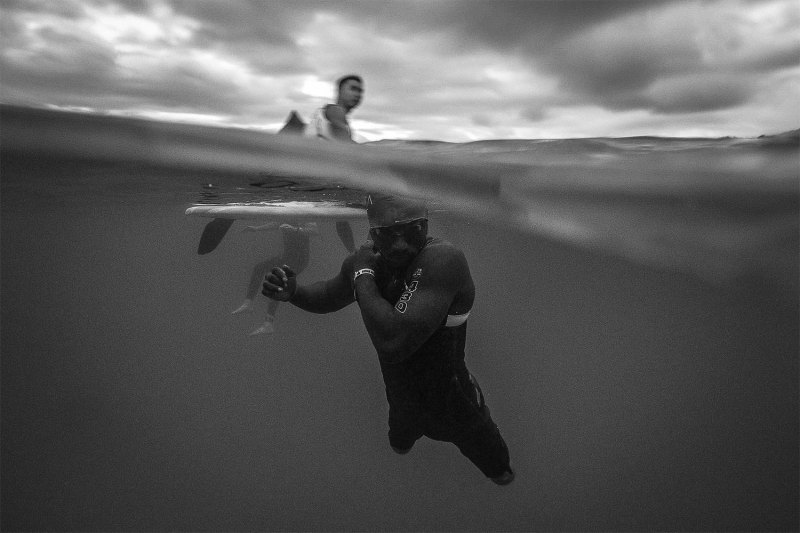An Olympic triathlon consists of a 0.93 mile swim, a 6.2 mile run, and a 24.8 mile bike ride. Tough stuff, to be sure. An Ironman triathlon consists of a 2.4-mile swim, a 26.22 mile marathon, and a 112 mile bike ride. Incredibly tough stuff — tougher than most people will ever complete or even attempt.
Roderick Sewell is not most people, though. When he crossed the finish line of an Ironman event in 2019, he entered the impressive ranks of Finishers in a category all his own: Sewell is the first double above-the-knee amputee to become an Ironman. And that would be impressive enough as it is, but when you know the road that led to that moment of victory, it’s all the more amazing a story. Because for much of Sewell’s youth, that “road” was the streets where he and his mother lived after falling into homelessness.

But you can take it back even before that; life wasn’t Easy Street for Roderick starting on day one. “I was born in San Diego, California, and with a birth defect that had me missing my tibias,” Sewell explains. “My mom really didn’t know what to do at the time. Doctors told her that I could be put in a wheelchair, or that she could consider amputation.”
Torn between committing her child to a life in a chair or a life without his actual legs but potentially upright on prosthetics, she chose the latter, and Roderick’s legs were surgically removed. And without that fraught decision, he might never have become a world class athlete.
But that would come years later. In the early years of his life, Roderick’s medical care costs put his mother in another almost impossible position: If she kept her job, the family would not receive enough health benefit support to cover the expensive prosthetic legs he needed (a child needs new prosthetics regularly as he or she grows), but if she gave up her job in order to secure full coverage, they would not have enough money to stay in their comfortable home. She put her son first, left work, and before long the family fell into homelessness. Roderick was eight years old.
But it was also around age eight that Roderick Sewell first became affiliated with the Challenged Athletes Foundation. Founded in San Diego in 1994 and with the mission “to provide opportunities and support to people with physical challenges, so they can pursue active lifestyles through physical fitness and competitive athletics,” CAF would change Sewell’s life.

“The people there [at CAF] were committed to getting people with disabilities what they needed for sports, but also helping out getting them just what they needed to live. We were overjoyed to be part of it.”
“As time goes by, I met my friend Rudy Garcia-Tolson, who is a Paralympic swimmer, and other athletes who gave me hope. I came to know I could do anything. I knew I wasn’t restricted by anything. If I wanted to do it, that was all that mattered.”
Over the next few years, as a swimmer, runner, and later a cyclist, Sewell trained with the U.S. Paralympics team, won bronze and gold medals in the 2014 Pan Pacific Para Swimming Championships, and finally set his sights on an Ironman competition. And as noted, after months of grueling training, Sewell became the first ever double above-the-knee amputee to earn the Ironman mantle.
He then proceeded to rest on his laurels. For about 10 minutes. Soon Sewell was training for the 2020 Paralympic Games. But of course 2020 had different plans for us all. With the games postponed, Roderick instead pivoted from focusing primarily on his own training to stepping up his work with the Challenged Athletes Foundation. In partnership with plant-based nutrition company VEGA, CAF and Sewell kicked off the (virtual) 2020 Community Challenge with a goal to raise one million dollars for disabled athletes. At the time of this writing, they are closing in on $850K, and there are still several weeks left. (That’s your hint to get involved, by the way.)

For Sewell, sports developed from a way to live a more normal life into his life’s calling. He described the process as organic, saying: “It’s not like a switch flipped and I just decided to try to be a serious athlete, I was just having fun, I worked hard because I cared, and it just progressed from there.”
To maintain his health and fitness, Sewell trains almost every day and usually cleaves to a vegan diet. “I’m on my bike more than ever these days. I love swimming. Basketball, any sport that keeps me active.”
When training for a specific event, like a triathlon, Sewell will usually swim 2,000 meters daily, run six miles, and bike for dozens. When not in training for a given challenge, not much changes. And the Paralympics are less than a year away, anyway.



